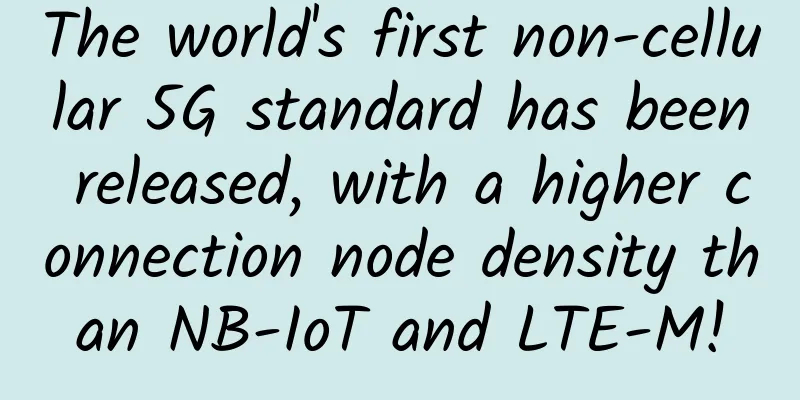The world's first non-cellular 5G standard has been released, with a higher connection node density than NB-IoT and LTE-M!

|
Recently, the DECT-2020 NR standard launched by the European Telecommunications Standards Institute (ETIS) has been recognized by the International Telecommunication Union (ITU) and included in the IMT-2020 technical recommendation as part of the 5G standard. This is the world's first non-cellular 5G technology standard, providing a complete set of standards for the industry to deploy 5G private networks. In the 5G era, private networks deployed for various industries have become a typical business model, and various technologies and standards for private networks have found broader applications.
Non-cellular 5G technologies: focus on uRLLC and mMTC scenariosDECT stands for Digital Enhanced Cordless Telecommunications, which was introduced in Europe in 1987 and has a 30-year development history, almost the same as public mobile communications. The standard operates in the 1880-1900MHz frequency band and can achieve high voice quality and security. Its original purpose was to achieve flexible digital wireless communications in residential, commercial and public environments. So far, it has been implemented in more than 1 billion short-distance communication devices worldwide. As time goes by and public mobile communications develop, DECT is also evolving. In addition to voice communications, it can also support Internet data communications and IoT communications. For example, in 2013, ETSI experts proposed a low-power version. At that time, the technology was aimed at smart home applications. In many overseas countries, DECT was used in some home energy management automation scenarios, but it could not replace Zigbee, Z-WAVE, etc. DECT-2020 NR is the latest version of the DECT standard released by ETSI in October 2020. It can be deployed in local networks, public clouds, or any other form of network architecture in between. According to the technical specifications released by ETSI, the main application scenarios of DECT-2020 NR include: highly reliable point-to-point and point-to-point link configurations; local wireless access based on star network topology supports uRLLC scenarios, and local access based on Mesh ad hoc network topology supports mMTC scenarios. It can be seen that DECT-2020 NR is more oriented towards the industrial applications of 5G Internet of Things. Among them, MESH networking is the biggest highlight of this version of the "non-cellular 5G standard". With the advantages of mesh communication, massive connections are achieved, meeting the 5G mMTC indicators proposed by ITU. An article published by several Finnish wireless communication experts in IEEE Communications Magazine shows that under the same latency and packet loss rate requirements, DECT-2020 NR has a higher connection node density than NB-IoT and LTE-M technologies included in 5G. DECT-2020 NR self-organizing network structure ETSI experts pointed out: In non-cellular 5G networks, each device is a node, and each device can be a router, just like each device is a base station. Devices will automatically find the best route and automatically add new devices to the network route. If a device fails, the devices will reroute themselves, which means reliable communication eliminates single points of failure. A decentralized network with low transmission power means less energy consumption. A study by a Finnish university shows that the energy efficiency of this system network is improved by about 60% compared to traditional cellular network topologies with the same transmission efficiency. In addition to the established 1900MHz DECT band, the DECT-2020 NR physical layer is also applicable to 17 bands below 6 GHz. Dynamic channel selection means that DECT-2020 NR does not require frequency planning and the complexity of the front end is relatively low. In addition, the DECT-2020 NR specification also proposes a compatible method with the 3GPP 5G standard, especially supporting access to the 3GPP 5G core network, such as accessing the 5G core network through N3IWF (Non-3GPP InterWorking Function). This flexibility also provides convenience for the deployment of industry-specific networks. Entering the $12 billion private network marketDECT-2020 NR provides a new option for global industry leaders who want to independently deploy independent private 5G networks. At present, the global 5G private network competition has begun. The scale of the private network market will be much larger than that of the 4G era, and various industries will also invest real money in this field. Juniper Research, a market research organization, recently released a report showing that various enhanced capabilities of 5G are driving enterprises' enthusiasm and awareness of private networks. By 2023, global annual spending on private network hardware and services will reach nearly $12 billion, an increase of 116% from the estimated $5.5 billion in 2021. Among them, 5G plays a key role in private networks. Among the base stations used in private networks deployed in 2023, 5G base stations account for more than 60%. Of course, one of the biggest barriers to deploying 5G private networks is the ability to obtain legal radio frequency resources. Due to the great differences in the management policies of radio frequencies among countries around the world, the development of 5G private networks is very uneven around the world. As we all know, Germany took the lead in introducing a special radio frequency support policy for 5G private networks, opening up very cheap and convenient private network frequency applications. A large number of industrial enterprises have obtained 5G private network frequency authorization; the United States has formed a 5G private network frequency authorization policy through the CBRS frequency band; Japan, South Korea, the United Kingdom and other countries have also introduced different forms of policies. Juniper Research believes that the global 5G private network deployment is very uneven, and the largest markets are those with the most open or flexible frequency allocations. Germany and the United States are leading in this regard. These two countries will account for 30% of global private network spending in 2023. As other countries release spectrum for private network use, this proportion may decline. In the industry sector, industrial and energy-related companies will become the core users of private network investment, accounting for nearly 60% of the investment market by 2023. However, Juniper Research also pointed out that although traditional operators dominate public cellular networks, they are likely to miss most of the private network market. Communication equipment manufacturers such as Ericsson and Nokia can directly provide private network equipment for large industry users and obtain part of the benefits of private network investment. Therefore, in the future global 5G private network market, a large number of new "operators" will be formed, and these operators will mainly provide network operation services for vertical industry users. Among them, some industry customers may form a team with communication network operation capabilities to serve their own private networks, or outsource this operation service to a third-party service provider. Given that private networks will become a new business model in the 5G era, multiple standardization organizations and industry chain companies are also continuously promoting the commercialization of private network technologies and products. 3GPP has also absorbed the research results of multiple organizations and members, such as 5G-ACIA's multi-defined private network scenarios, and promoted the formulation and evolution of NPN (non-public network) standards. At present, China's 5G is in a period of rapid construction. For 5G private networks, there is no 5G private network frequency policy yet, and it is impossible to realize the implementation of a completely independent 5G private network, but more focused on the "public network dedicated" model. In July this year, ten ministries and commissions jointly issued the "5G Application "Sailing" Action Plan (2021-2023)", in which the "Strengthening 5G Frequency Resource Guarantee" measures clearly proposed: Conduct 5G industrial dedicated frequency requirements and other radio system compatibility research, and study and formulate 5G industrial dedicated frequency use license models and management rules suitable for my country. It seems that it will take some time for independent 5G private networks to come into being, and major operators are actively launching related products for public network private networks, opening up a 5G private network development path with Chinese characteristics, covering models from network slicing to independent private networks, in which independent private networks are actually achieved by renting operator frequencies. At present, the implementation of 5G private networks in China is accelerating. Taking China Mobile as an example, in 2020, China Mobile released a 5G private network product system, including three modes of "premium, exclusive, and exclusive". Over the past year, more than 1,500 5G private network commercial projects have been built in various industries. Recently, China Mobile released the 5G private network product system 2.0. Based on the 1.0 system, the new system focuses on 18 sub-industries such as factories and mines. With the acceleration of 5G commercialization, there will be a situation of a hundred schools of thought on 5G private networks. The release of the world's first non-cellular 5G standard by ETSI is to contribute to the 5G private network ecosystem at the standard level. It will surely be implemented in some industries in the future and will also give birth to a rich group of 5G private network innovation groups. |
Recommend
A comprehensive analysis of IoT positioning technology! Positioning is moving from outdoor to indoor
As early as the 15th century, when humans began t...
Friendhosting Christmas/New Year promotion, 40% off all VPS hosts, unlimited traffic in multiple computer rooms
Friendhosting launched a promotion for Christmas ...
Let's talk about IPv4 to IPv6 tunnel
[[273990]] When is IPv6 tunneling used? Connect t...
ZJI Golden Autumn Brings Coolness: 40% off on Hong Kong Kwai Wan High Defense Servers, 32% off on designated models in Hong Kong Tai Po
ZJI has launched the second wave of its September...
In the past six years, the total financing of my country's 5G industry has reached 127.874 billion yuan, with China Unicom leading the way
5G commercial use is about to enter the fast lane...
In-depth analysis of common three-way handshake exceptions
[[416112]] This article is reprinted from the WeC...
The past and present of IPv6 and the comparison with IPv4
IPv6 is the abbreviation of Internet Protocol Ver...
Huawei Vice Chairman Hu Houkun: Crossing the business chasm and creating new 5G value
During the 2020 Global Mobile Broadband Forum, Hu...
Five network management trends for 2022
With the advent of the Internet era, people need ...
DesiVPS: $110/month-2*E5-2670v2/64GB/1TB SSD/30TB@10Gbps/San Jose data center
DesiVPS is a foreign hosting company headquartere...
August of the three major operators: 5G is accelerating, and China Mobile's fixed-line broadband users have exceeded 200 million
2020 was a difficult year, but it went by very qu...
Don’t be too eager to “eat meat” with 5G messaging
During the "2021 China International Informa...
SD-WAN is about to dominate edge networks
Network transmission is like playing a team battl...
“Hotel chains” also have “five-star” Wi-Fi! How did Lavande Hotels do it?
Hotel Wi-Fi ≈ Slow speed and insecurity? This pro...
SpartanHost: Seattle High Defense E5 series KVM restock, 1G memory, 15GB NVMe hard drive, 2TB/10Gbps monthly payment of $5
SpartanHost is a well-known foreign VPS hosting c...









